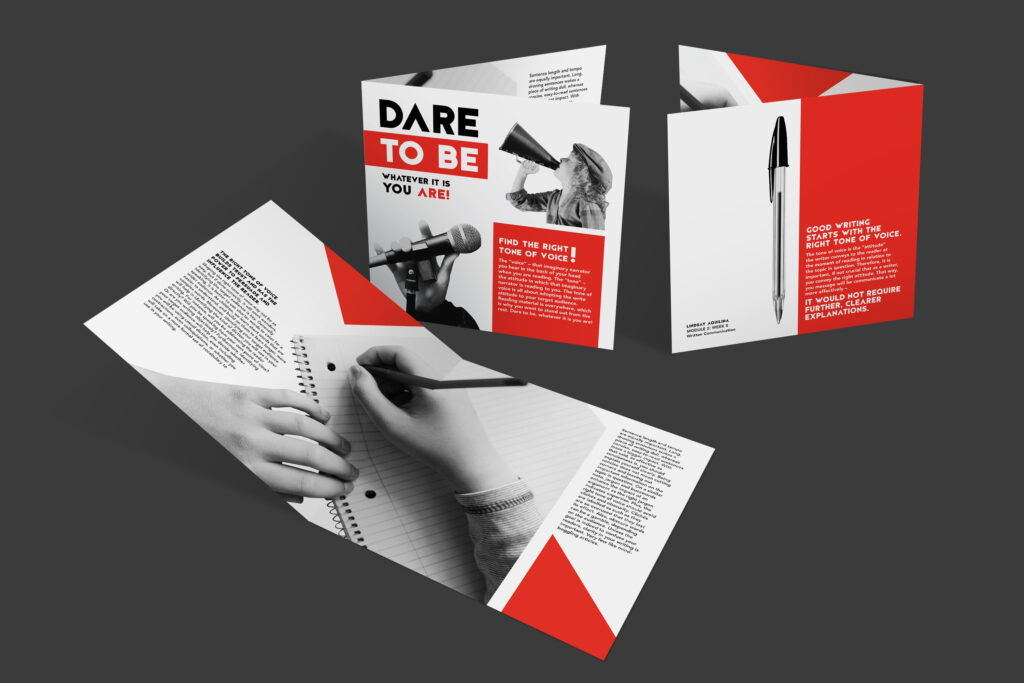
THe Right TONE OF VOICE – A MINI MANIFESTO

A Brief Intro…
As we kicked of the second brief for the module, we started off by looking at what makes up the tone of voice and how it varies, depending on your audience. Unlike the writing style – where is can be unique yet recurring in an author’s writings, the tone of voice can vary greatly depending on you is the target audience for that piece of writing. With that said, we were to look at different tones of voice from a preselected list (which will be listed below) and sum it up in a writeup, adopted one of the tones of voice that was selected for us. I explored different styles and my writeup turned out to be a sort of instructional manifesto sort of tone.
The list of tones of voice is as follows:
- A news story
- A children’s story
- A launch document for a brand
- A love letter
- A business plan
- A diary
- A manifesto/speech
In the next section, you can read my answer to this week’s challenge named Dare to Be – Find The Right Tone of Voice. Enjoy.
The Workshop Challenge

Dare to Be! – Find The Right Tone of Voice
The “voice” – that imaginary narrator you hear in the back of your head when you are reading. The “tone” – the attitude in which that imaginary narrator is reading to you. The tone of voice is all about adopting the write attitude to your target audience. Reading material is everywhere, which is why you want to stand out from the rest. Dare to be, whatever it is you are!
The right tone of voice builds trust and has the power to persuade and influence the reader. Shaping the right tone of voice may not be as easy, but if done correctly, it will work wonders. Identifying the target audience is key. Generally speaking, it is better to use shorter words to cater for a wider audience. As children, we learn short words that are easier to understand, and build on them to learn longer, more complex words. Moreover, identifying your target audience will help in identifying the kind of diction you will use in your writing. For instance, will you be addressing the reader directly? Will you be speaking from your own point of view? Or are you writing objectively? Furthermore, identifying your target audience will help you decide whether you will be using casual diction, even including contractions, even colloquialisms, or whether you will take on a more formal set of vocabulary to use in your writing.
Sentence length and tempo are equally important. Long, droning sentences wakes a piece of writing dull, whereas concise, easy-to-read sentences leave a bigger impact. With that said, as effective as conciseness is, you should explain yourself clearly. Being concise does not mean cutting corners and leaving out important information on the topic in question. On a similar note, jargon and buzzwords enhance the impact of an argument as the right jargon indicates expertise. Plus, the right tone of voice should avoid clichés and obscurity. Clichés are labelled as such as they are so overused that they lost its effect. Also, obscure words can be a gamble, depending on the audience. Unless the goal is indeed to confuse your readers, clarity in your writing is important. Very few like mind-boggling articles.
Good writing starts with the right tone of voice. The tone of voice is the “attitude” the writer conveys to the reader at the moment of reading in relation to the topic in question. Therefore, it is important, if not crucial that as a writer, you convey the right attitude. That way, you message will be communicate a lot more effectively – it would not require further, clearer explanations.





